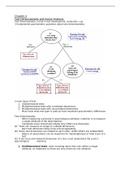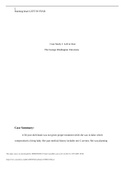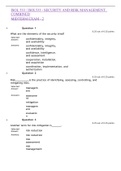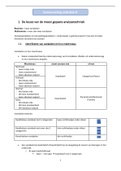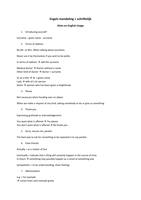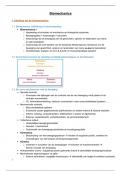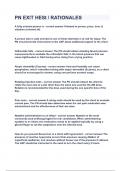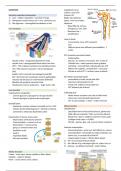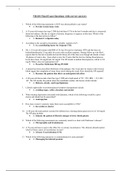Macroeconomics
Topic 2. Minsky’s financial instability hypothesis.
According to the neoclassical efficient market hypothesis, instability is exogenous and occurs due to
external shocks. Following Walrasian theories, neoclassical economists claim that the market can self-
regulate itself to achieve a static equilibrium (which is also claimed to be Pareto efficient) with no need of
external interventions. They argue instead that it is because of exogenous interventions in the economy, for
instance by policymakers and governmental officials, that market forces are disrupted and not able to
achieve the equilibrium and the optimal allocation of scarce resources.
However, such theory rests upon unrealistic assumptions, namely perfect foresight and knowledge of the
future and rational individuals who maximize their utility function given perfect information fully reflected
and carried by market prices. These assumptions do not reflect reality, and hence it follows logically that
these make up for a theory that is unrealistic. However, this was the theory upon which economists and
policymakers based their political agendas after 1980s in the US with important policy implications, namely
the deregulation of the economy and particularly, of the financial sector, and the ever less stringent
segmentation of commercial and investment banks required by the 1933 Glass-Stegall Act.
Due to the use of a positivist methodology and following Friedman’s beliefs, according to which unrealistic
assumptions do not invalidate the theory itself which instead finds its validation via successful hypothesis
testing, the neoclassical approach to economic laws found fertile ground and blossomed in the US and
particularly, after the Glass-Stegall Act had been repealed in 1999. Hence, not only economists relied upon
a theory based on assumptions that did not even resemble nor approximate reality, but also, they were
often inclined to accept the new theoretical framework provided by the new neoclassical mainstream
because of increasing corruption taking place in the offices of Wall Street lobbying governmental officials’
campaigns in exchange of freer markets and deregulations.
Opposing such theoretical economic framework was the Keynesian-Minskyan analysis of the economy.
Minsky argued that instability is endogenous in capitalist economies and that it is caused by endogenous
processes that increase financial fragility tending towards economic instability. Hence, the need of
regulation. Minsky elaborates the financial instability hypothesis, expanding on Keynes’ General Theory and
incorporating the Kalecky-Levy’s equation of aggregate profits. Building upon assumptions that at least
approximate reality, Minsky generates a model of accumulating capitalist economies that describes the
development of business cycles as due to endogenous dynamics that take place in an environment that is
subject to regulations and interventions. Such “thwarting” mechanisms are designed to prevent instability
representing attempts at stabilizing the economy, which is per se unstable. Such hypothesis will be the
focus of the following analysis.
The essay will first illustrate Minsky’s financial instability hypothesis to explain how endogenous dynamics
lead to increasing financial fragility that can implode and lead to instability. First, the structure of the
economy will be analysed according to the Minskyan taxonomy of financial units, and then the Minskyan
business cycle will be described; this being the result of two main cycles: a basic and a super Minskyan
cycle, which take place at the same time. Secondly, the analysis will move forward to describe Minsky’s
policy implications in light of his hypothesis, even though Minsky was less confident on the success of such
policies than he was about his hypothesis, mainly because, due to an ever-changing economic environment
and due to financial units trying to constantly escape and avoid such regulations, policies will need to
constantly adapt and change as well. The essay will then ultimately discuss some of the limitations of
Minsky’s hypothesis which were not taken into account when formulating the hypothesis and were hence
wrongfully disregarded by Minsky. Ultimately, a brief conclusion will present a personal evaluation of the
hypothesis arguing that despite the above-mentioned limitations, Minsky’s hypothesis has explained one of
, the fundamental and crucial causes of why financial crises may occur, namely the impact of debt on the
economy and the changes in liquidity preferences of businessmen and bankers according to the
surrounding environment, and successfully managed to link the real and the financial sector, a link which
was instead missing in the neoclassical efficient market hypothesis.
BEHIND MINSKY’S FINANCIAL INSTABILITY HYPOTHESIS: THE BASIS OF THE THEORY
Firstly, Minsky’s hypothesis assumes individuals do not have perfect foresight, and they are aware that
their expectations and knowledge about the future are not certain. Hence, following Keynes, Minsky’s
hypothesis assumes that uncertainty is inherent to the economy, as the future cannot be foreseen. He then
expands on Keynes’ investment theory adding his financial theory of investment. According to Keynes, the
driving variable in the determination of aggregate demand is the investment decisions that take place in
the economy and operate via the spending multiplier. The aggregate level of effective demand is then the
main factor that generates equilibrium levels of employment, output, and income. According to Keynes,
investment will be undertaken, hence raising income, output, and employment, whenever the marginal
efficiency of any capital asset exceeds the marginal efficiency on liquid financial assets. Such process of
growth will continue until there is no marginal efficiency of capital assets exceeding that of liquid assets.
Minsky builds upon Keynes’ liquidity preference theory of asset prices, which is linked to the theory of the
multiplier and of effective demand, explaining how investment will be financed, whenever financial units
will decide to undertake it, namely via borrowing, hence leading to rising debt and asset price inflation.
Firstly, Minsky adds two key blocks to the theory: a “two price system” and “the lender and borrower’s
risk” notion.
Figure 1. Determination of Level of Investment
PK PIS
PI PID
OIF OID
Firstly, the current output price system determines the supply price of capital, at a level that will generate
profits “as long as the administered price can be maintained with adequate sales”. Purchase of capital
assets can be either financed via internal funds (as through sales revenue) or via external funds and so
through borrowing, which raises the price administered by suppliers due to lender’s risk covered by explicit
finance costs of borrowed funds via an interest rate for instance. Hence, the total supply price increases
when the quantity of the investment is expected to be purchased by using external funds.
On the other hand, the asset price system incorporates the borrowers’ risks into demand prices. Minsky
argues that the price one is willing to pay for an asset also depends on the amount of external funds,
because the greater the borrowing required, the greater the risk of insolvency. Unlike the lender’s risk
though, the borrowers’ risk is solely subjectively and conventionally determined depending on subjective
expectations, reflected on the margins of safety required. More optimistic expectations lead to a reduction
in the margin of safety, and vice versa. Hence, Minsky argues, following Kalecki’s principle of increasing risk,
Topic 2. Minsky’s financial instability hypothesis.
According to the neoclassical efficient market hypothesis, instability is exogenous and occurs due to
external shocks. Following Walrasian theories, neoclassical economists claim that the market can self-
regulate itself to achieve a static equilibrium (which is also claimed to be Pareto efficient) with no need of
external interventions. They argue instead that it is because of exogenous interventions in the economy, for
instance by policymakers and governmental officials, that market forces are disrupted and not able to
achieve the equilibrium and the optimal allocation of scarce resources.
However, such theory rests upon unrealistic assumptions, namely perfect foresight and knowledge of the
future and rational individuals who maximize their utility function given perfect information fully reflected
and carried by market prices. These assumptions do not reflect reality, and hence it follows logically that
these make up for a theory that is unrealistic. However, this was the theory upon which economists and
policymakers based their political agendas after 1980s in the US with important policy implications, namely
the deregulation of the economy and particularly, of the financial sector, and the ever less stringent
segmentation of commercial and investment banks required by the 1933 Glass-Stegall Act.
Due to the use of a positivist methodology and following Friedman’s beliefs, according to which unrealistic
assumptions do not invalidate the theory itself which instead finds its validation via successful hypothesis
testing, the neoclassical approach to economic laws found fertile ground and blossomed in the US and
particularly, after the Glass-Stegall Act had been repealed in 1999. Hence, not only economists relied upon
a theory based on assumptions that did not even resemble nor approximate reality, but also, they were
often inclined to accept the new theoretical framework provided by the new neoclassical mainstream
because of increasing corruption taking place in the offices of Wall Street lobbying governmental officials’
campaigns in exchange of freer markets and deregulations.
Opposing such theoretical economic framework was the Keynesian-Minskyan analysis of the economy.
Minsky argued that instability is endogenous in capitalist economies and that it is caused by endogenous
processes that increase financial fragility tending towards economic instability. Hence, the need of
regulation. Minsky elaborates the financial instability hypothesis, expanding on Keynes’ General Theory and
incorporating the Kalecky-Levy’s equation of aggregate profits. Building upon assumptions that at least
approximate reality, Minsky generates a model of accumulating capitalist economies that describes the
development of business cycles as due to endogenous dynamics that take place in an environment that is
subject to regulations and interventions. Such “thwarting” mechanisms are designed to prevent instability
representing attempts at stabilizing the economy, which is per se unstable. Such hypothesis will be the
focus of the following analysis.
The essay will first illustrate Minsky’s financial instability hypothesis to explain how endogenous dynamics
lead to increasing financial fragility that can implode and lead to instability. First, the structure of the
economy will be analysed according to the Minskyan taxonomy of financial units, and then the Minskyan
business cycle will be described; this being the result of two main cycles: a basic and a super Minskyan
cycle, which take place at the same time. Secondly, the analysis will move forward to describe Minsky’s
policy implications in light of his hypothesis, even though Minsky was less confident on the success of such
policies than he was about his hypothesis, mainly because, due to an ever-changing economic environment
and due to financial units trying to constantly escape and avoid such regulations, policies will need to
constantly adapt and change as well. The essay will then ultimately discuss some of the limitations of
Minsky’s hypothesis which were not taken into account when formulating the hypothesis and were hence
wrongfully disregarded by Minsky. Ultimately, a brief conclusion will present a personal evaluation of the
hypothesis arguing that despite the above-mentioned limitations, Minsky’s hypothesis has explained one of
, the fundamental and crucial causes of why financial crises may occur, namely the impact of debt on the
economy and the changes in liquidity preferences of businessmen and bankers according to the
surrounding environment, and successfully managed to link the real and the financial sector, a link which
was instead missing in the neoclassical efficient market hypothesis.
BEHIND MINSKY’S FINANCIAL INSTABILITY HYPOTHESIS: THE BASIS OF THE THEORY
Firstly, Minsky’s hypothesis assumes individuals do not have perfect foresight, and they are aware that
their expectations and knowledge about the future are not certain. Hence, following Keynes, Minsky’s
hypothesis assumes that uncertainty is inherent to the economy, as the future cannot be foreseen. He then
expands on Keynes’ investment theory adding his financial theory of investment. According to Keynes, the
driving variable in the determination of aggregate demand is the investment decisions that take place in
the economy and operate via the spending multiplier. The aggregate level of effective demand is then the
main factor that generates equilibrium levels of employment, output, and income. According to Keynes,
investment will be undertaken, hence raising income, output, and employment, whenever the marginal
efficiency of any capital asset exceeds the marginal efficiency on liquid financial assets. Such process of
growth will continue until there is no marginal efficiency of capital assets exceeding that of liquid assets.
Minsky builds upon Keynes’ liquidity preference theory of asset prices, which is linked to the theory of the
multiplier and of effective demand, explaining how investment will be financed, whenever financial units
will decide to undertake it, namely via borrowing, hence leading to rising debt and asset price inflation.
Firstly, Minsky adds two key blocks to the theory: a “two price system” and “the lender and borrower’s
risk” notion.
Figure 1. Determination of Level of Investment
PK PIS
PI PID
OIF OID
Firstly, the current output price system determines the supply price of capital, at a level that will generate
profits “as long as the administered price can be maintained with adequate sales”. Purchase of capital
assets can be either financed via internal funds (as through sales revenue) or via external funds and so
through borrowing, which raises the price administered by suppliers due to lender’s risk covered by explicit
finance costs of borrowed funds via an interest rate for instance. Hence, the total supply price increases
when the quantity of the investment is expected to be purchased by using external funds.
On the other hand, the asset price system incorporates the borrowers’ risks into demand prices. Minsky
argues that the price one is willing to pay for an asset also depends on the amount of external funds,
because the greater the borrowing required, the greater the risk of insolvency. Unlike the lender’s risk
though, the borrowers’ risk is solely subjectively and conventionally determined depending on subjective
expectations, reflected on the margins of safety required. More optimistic expectations lead to a reduction
in the margin of safety, and vice versa. Hence, Minsky argues, following Kalecki’s principle of increasing risk,

